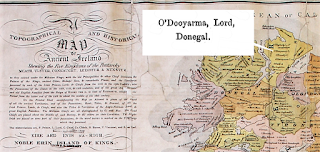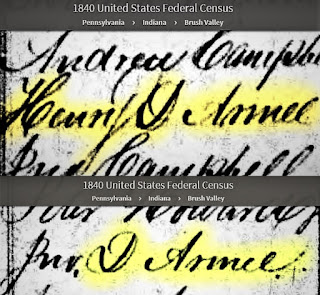The foreground area in the above photo is part of the Commune of Chateauvieux (equivalent to a rural U.S. township rather than a single village), located on a piedmont plateau in the French Alps, just south of the city of Gap.
Chateauvieux is familiar to generations of amateur family genealogists who have read "DeArmond Families of America" (1954) by Roscoe Carlisle "d'Armand". There are several locations throughout France referred to as Chateauvieux. Search engine map and photo correlation to nearby Venterol, France confirms that the location subject of this post without doubt includes the scenic view in the above photo. According to the opening pages of his book, the many variations of the DeArmond surname found in North America trace their origin back to the British Isles and once noble French Huguenot refugees. Roscoe conjectured that his proposed refugees during the late 17th century had made their way by supposed means and routes to London from their homes in the Dauphine or Haute Alps region where his referred to Chateauvieux is located in southeast France.
In fact, many thousands of Protestants (Huguenots) from much of France did indeed flee to neighboring Protestant countries during that time period. They did so to escape from mobs of Catholics intent on torturing and murdering the Calvinist Protestants after French king Louis XIV blindly responded to the urging of his pious converted Catholic second wife Madame de Maintenon who wished merely for Protestants to convert as she had done, not realizing the upheaval and suffering her influence would cause. In 1685 Louis unwisely revoked the Edict of Nantes religious peace treaty of 1598. This caused France to lose a vital segment of population, thereby weakening it's economic strength in Europe, felt even to present day. Roscoe was able to obtain copies of genealogies and an armorial coat of arms for the noble family known as d'Armand de Chateauvieux, whose Protestant male members he postulated to be the progenitors of the various DeArmond surname variant immigrant lines to North America that he listed in his work.
Right: Roscoe Carlisle "d'Armand". Left: Coat of Arms of d'Armand which Roscoe purported to represent the DeArmond family crest.
In fact, many thousands of Protestants (Huguenots) from much of France did indeed flee to neighboring Protestant countries during that time period. They did so to escape from mobs of Catholics intent on torturing and murdering the Calvinist Protestants after French king Louis XIV blindly responded to the urging of his pious converted Catholic second wife Madame de Maintenon who wished merely for Protestants to convert as she had done, not realizing the upheaval and suffering her influence would cause. In 1685 Louis unwisely revoked the Edict of Nantes religious peace treaty of 1598. This caused France to lose a vital segment of population, thereby weakening it's economic strength in Europe, felt even to present day. Roscoe was able to obtain copies of genealogies and an armorial coat of arms for the noble family known as d'Armand de Chateauvieux, whose Protestant male members he postulated to be the progenitors of the various DeArmond surname variant immigrant lines to North America that he listed in his work.
Right: Roscoe Carlisle "d'Armand". Left: Coat of Arms of d'Armand which Roscoe purported to represent the DeArmond family crest.
The nobility of France were primarily of Germanic ancestry stemming from invasions of Teutonic tribes after the collapse of the Roman empire. The name Armand, which is both a common given name and surname in Latin Europe, derives from the Germanic name of Heri-mann or Herman meaning "army man". The patronymic prefix d' or de means "of " or "from", and once signified status of nobility in pre-revolutionary France. Chateauvieux is actually two words meaning "old castle" with the adjective reversed in English. Roscoe proudly included several pages of genealogy records concerning members of the d'Armand de Chateauvieux extended family, with those who were Calvinist Protestants having to flee France after 1685. Here we first begin to notice the sketchy anomalies in Roscoe's narrative.
Huguenot refugee routes and population estimates for various areas accepting the Huguenots. Chateauvieux was located nearest to Grenoble shown on the map. Only possible piecemeal and no direct representation of refugee travel from this area to England is indicated. Musee virtual de Protestantisme Francais.
From the map just above, it appears that Roscoe's story line that the d'Armand refugee families would have taken the long arduous and dangerous journey from southeast France to London would have been highly unlikely for Huguenots from the Alps piedmont region or even later via Switzerland and then Holland. Chateauvieux was located in an area of predominately Protestant population as were many regions of southern France, known for the ill fated late medieval Albigensian Catharism movement. The infamous quote "Kill them all, let God sort them out!"(as to who is Cathar or Catholic) originates from a Catholic bishop's order in 1209 to slaughter several thousand surviving inhabitants of a French Mediterranean coastal city after being sacked by a crusader army. The Chateauvieux region of 1685 did not necessitate the immediate urgency to flee the country for survival as critically as in northern areas of France where most of the Huguenot refugees of England fled from to save their lives or escape persecution.
Sketch of French Protestant church on London's Threadneedle street. The church was demolished in 1840. About 1700, French Huguenot refugees represented about 5% of the population of London, most being skilled artisans or businessmen, helping to boost the British economy.
Roscoe's belief that d'Armand families of Chateauvieux found refuge in London and were members of the Protestant "French Church" on Threadneedle street is based on a very thin assumption. On page 15 he proposed that the father of the Armand brothers, listed as Espirit Armand,"was perhaps a younger son of Georges d'Armand de Chateauvieux of Venterol, France" (6 km from Chateauvieux). I have failed to discern where Roscoe specifies a citation reference that can be found to support this critical alleged birth location at Venterol. Without valid documentation to support this contention, his entire noble French Huguenot origin story is merely his wishful supposition. In his North American research, he scrupulously researched and noted sources, but in recounting his old world record research, he was subject to flights of childlike fantasy. He cites several marriages and baptisms of the Armand family listed in the Threadneedle street church records. The registers of the French Church of Threadneedle street are extensive, covering nearly two centuries and are included in several volumes. They are very unwieldy to peruse on line. I was hoping to find justification for Roscoe's assumption of connection to the Chateauvieux area, but decided the effort to search the registers was not worth my time or interest.
Roscoe used a series of illogical and unfeasible logistical, social-economic and timeline circumstances to support his fantasized contention of the Armands of London's Threadneedle street being one and the same as the early DeArmond surname variants found in 18th century northern Ireland. To preclude his own doubts about having any connection at all to the French Huguenots, he imagined the possibility of a Presbyterian minister led group emigration to America from England instead of Ireland, that included Roscoe's ancestor. This was done in order to suggest his own surname line spelling was not corrupted by association with Irish names. The early DeArmond surname variant immigrants, including Roscoe's ancestor were exclusively Catholics who converted to the Presbyterian Church in order to lawfully take vacant tenant farming work. Presbyterianism was a Scottish and Ulster Scot religion not usually found or practiced widely in England. The English Anglicans considered Presbyterianism to be a "dissenter" or "non-conformist" religion and passed restrictive laws against it. This would later contribute to the rough and ready American Presbyterian Scots-Irish being the major patriot combatants in the revolution which was referred to as an "Irish war" by many British military officers. In his fairy tale version of history, Roscoe blindly ignored these critical historical factors or simply was ignorant of them.
My primary reason however, for discontinuing the effort to follow Roscoe's contention of an ancestral connection of the London Armand family to Chateauvieux, France, is answered in the following tree chart of Y chromosome DNA tested results of three descendants of Roscoe's own immigrant ancestor James, whom he designated as Line A. All three are positive for a Y DNA SNP FGC4113. This SNP is indicative of paternal line descent only from the native Irish clan of O'Duibhdhiorma, who for at least the past 1500 years have been indigenous inhabitants of the eastern Inishowen peninsula of northern Donegal, Ireland.
Y chromosome DNA tree chart of three descendants of James Line A who tested positive for Y DNA SNP FGC4113, indicating strictly a native Irish ancestry for James paternal line ancestors. The Y chromosome pedigree traces back to indigenous habitation in northwest Ireland centuries before a semblance of a French language began to emerge in western Europe.















































